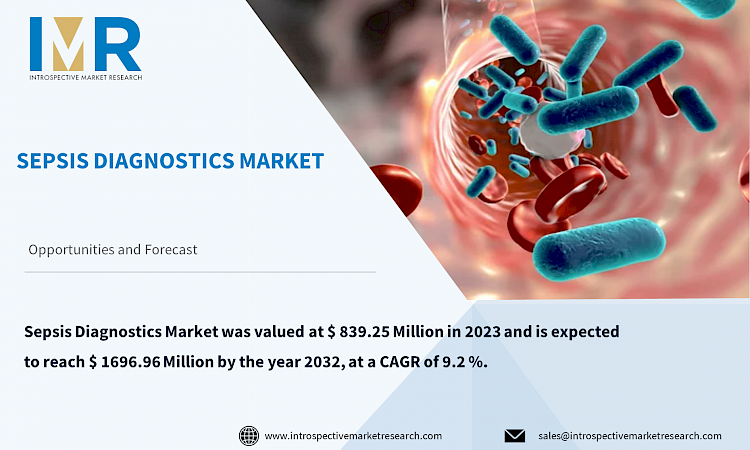Sepsis Diagnostics Market
According to a new report published by Introspective Market Research, titled, “Sepsis Diagnostics Market by Technology, Product, Method, Pathogen, Test Type, End User, and Region Global Market Analysis and Forecast, 2024-2032.
The Global Sepsis Diagnostics Market was valued at $ 839.25 Million in 2023 and is expected to reach $ 1696.96 Million by the year 2032, at a CAGR of 9.2 %.
Sepsis diagnosis refers to the methods and processes used by healthcare professionals to identify and confirm sepsis, a potentially life-threatening condition caused by the body's overwhelming response to infection. Diagnosis usually uses a combination of clinical assessments such as vital signs, laboratory tests, and sometimes imaging studies to identify specific signs of infection throughout the body. The sepsis diagnostics market encompasses a wide range of tools, technologies, and methods used in healthcare to detect and treat sepsis. Sepsis is a critical condition caused by the body's response to infection. The market for these diagnostic tools has grown steadily due to several factors. These include the increasing incidence of sepsis worldwide, the development of diagnostic technologies that provide faster and more accurate results, and the increasing emphasis on early detection and intervention to improve patient outcomes.
According to The Sepsis Diagnostics Market is segmented into Technology, Product, Method, Pathogen, Test Type, and End-Users. By Technology, the market is categorized into Blood Culture, Immunoassays, Molecular Diagnostics, Flow Cytometry, Microfluidics, and Biomarkers. By Product, the market is categorized into Blood Culture Media, Assays and reagents, Instruments, and Software. By Method, the market is categorized into Automated Diagnostics and Conventional Diagnostics. By Pathogen, the market is categorized into Bacterial Sepsis, Fungal Sepsis, and Viral Sepsis. By Test Type, the market is categorized into Laboratory Tests and Point-of-Care Tests. By Pathogen, the market is categorized into Hospitals and specialty clinics, Pathology and reference Laboratories, Research Laboratories, and academic Institutes. By region, it is analyzed across North America (U.S.; Canada; Mexico), Eastern Europe (Bulgaria; The Czech Republic; Hungary; Poland; Romania; Rest of Eastern Europe), Western Europe (Germany; UK; France; Netherlands; Italy; Russia; Spain; Rest of Western Europe), Asia-Pacific (China; India; Japan; Southeast Asia, etc.), South America (Brazil; Argentina, etc.), Middle East & Africa (Saudi Arabia; South Africa, etc.).
There are several diagnostic methods on the market, from routine laboratories. tests such as blood culture biomarker assays (such as measurement of procalcitin or C-reactive protein levels) to advanced techniques such as molecular diagnostics and point-of-care testing. The integration of new biomarkers and rapid diagnostic tools into healthcare systems has shown promising results in improving sepsis detection and subsequent treatment strategies.
The rising incidence of Hospital Acquired Infections (HAI) is a key driver for the sepsis diagnostic market growth. HAIs, also known as nosocomial infections, are infections that patients acquire during a hospital stay, often associated with exposure to invasive procedures, medical devices, or healthcare workers. These infections are a major risk factor for the development of sepsis because they introduce pathogens to susceptible patients that can cause systemic infections and subsequent organ failure.
Sepsis is a very difficult disease to diagnose, hypertensive patients with septic shock have a 7.6% increased risk of mortality even with a 1-minute delay. Thus, the need for rapid diagnosis of sepsis increases to reduce the delay in antibiotic therapy in sepsis patients. Many manufacturers of sepsis diagnostics are expanding their product range in point-of-care technology that quickly detects sepsis and shortens the time to diagnosis.
Global Sepsis Diagnostics Market, Segmentation
Sepsis Diagnostics Market Segmented Based on Technology, Product, Method, Pathogen Test Type, End-Users, and Region.
Technology:
The blood culture segment is expected to dominate the market during the forecast period. Blood culture methods involve culturing a sample of the patient's blood to identify the specific pathogens causing the infection. Although still the gold standard, it often requires a longer time (hours to days) to obtain results, which can delay the initiation of targeted therapy. Despite this drawback, blood cultures have historically been widely used to identify causative organisms in sepsis.
However, the landscape is moving towards faster and more advanced technology. Immunoassays, molecular diagnostics, and biomarkers are becoming increasingly important due to their ability to provide faster results and, in some cases, greater accuracy. For example, immunoassays detect specific proteins or antibodies in the blood that help identify infections. Molecular diagnostics, including polymerase chain reaction (PCR) tests, can detect the DNA or RNA of pathogens, allowing rapid and specific detection.
Biomarkers such as procalcitonin and C-reactive protein are also increasingly used as indicators of infection and for clinical decision-making. They give quick results and help distinguish sepsis from other diseases.
Product:
Assays and reagents form a central category in sepsis diagnosis, forming a diverse set of essential tools and components that are integral to accurate and efficient diagnosis. This category includes a wide range of diagnostic methods, including immunoassays and molecular analyses, as well as critical reagents for the detection of sepsis-related infections and pathogens. These diagnostic tools are essential for performing accurate tests to identify biomarkers, proteins, or genetic material indicative of specific infections, allowing doctors to quickly and accurately diagnose sepsis.
Immunoassays, an important part of this segment, include methods that detect and quantify specific molecules such as antigens or antibodies present in blood or other body fluids. These tests help identify markers associated with infection and greatly advance the diagnostic process. Molecular tests, on the other hand, examine the genetic material of pathogens, which allows the detection of specific DNA or RNA sequences of infectious agents. This understanding at the molecular level will play a crucial role in identifying the exact causative pathogens underlying sepsis and guiding targeted treatment strategies.
Region:
North America is Expected to Dominate the Market Over the Forecast Period.
North America is an established market for medical devices. The main factors are a highly developed healthcare system, the widespread adoption of innovative sepsis diagnostic methods by medical professionals, the overwhelming number of surgical procedures, the increasing incidence of healthcare-associated infections (HAI), and the technological development of sepsis diagnoses. growth of the sepsis diagnosis market in North America.
The United States has historically dominated the sepsis diagnosis market. The US healthcare sector is characterized by a sophisticated infrastructure, strong research and development initiatives, and a strong focus on technological innovation. These factors contribute to the country's leading position in sepsis diagnostic field advancements and market growth.
Some of The Leading/Active Market Players Are-
- Luminex (US)
- T2 Biosystems (US)
- Danaher Corporation (US)
- Dickinson and Company (US)
- Thermo Fisher Scientific (US)
- Bruker Corporation (US)
- Abbott Laboratories (US)
- Quidel Corporation (US)
- AdvanDx (US)
- Immunoexpress, Inc (US) and Other Active Players
Key Industry Developments
- In November 2023, The University of Oxford partnered with Danaher Corporation to develop a new test to enable precision medicine care for sepsis.
- In November 2023, Oxford Nanopore Technologies collaborated with Day Zero Diagnostics to develop an end-to-end diagnostic solution for bloodstream infections.
Key Findings of the Study
- North America, particularly the United States, is expected to dominate the market due to its highly developed healthcare system, adoption of innovative diagnostic methods, and technological advancement.
- The blood cultures segment is expected to dominate the market during the forecast period due to its longer revenue periods.
- Advanced techniques such as immunoassays, molecular diagnostics, and biomarkers are proliferating because they can provide faster and often more accurate results.







